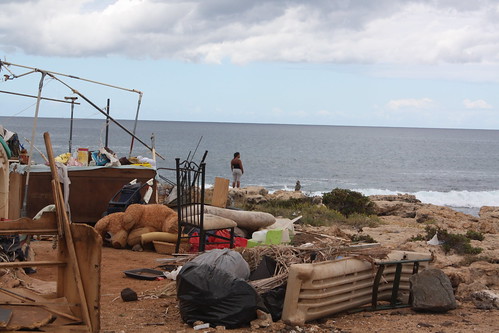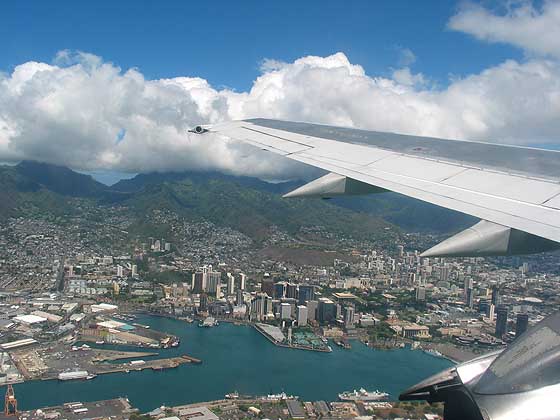Residents raise concerns of gridlock, ‘homelessness,’ and industrial waste in Waianae plan
WAIANAE—The Waianae Coast is a place of spectacular coastlines, dramatic backdrops, and a rich history. The Waianae Sustainable Communities Plan (WSCP), which is intended to guide future development decisions, acknowledges that the area is blessed with so much yet, at the same time, saddled with many challenging issues.
As the proposed updated WSCP reaches its final stages, residents still have opportunities to contribute to the discussion. A public informational meeting will be held Wednesday, November 10 at St. Philips Church in Maili from 7:00 p.m. to 9:00 p.m. A public hearing by the City and County of Honolulu’s Planning Commission is tentatively scheduled on December 15, 2010.
With a population that has skyrocketed from 3,000 in 1950 to an estimated 50,000 today, the Waianae District is the most developed of the rural communities on Oahu. It also houses the majority of both the island’s “homeless” as well as the “hidden homeless,” those who are residing with family members and friends. The result is an abundance of affordable housing projects that, in addition to drawing more people to the area, put a stress on infrastructure and public facilities.

Another feature that differentiates Waianae from other rural areas is that its valleys aren’t always reminiscent of the pastoral idyllic. Waianae is also home to vast military operations and is the place where much of the island’s waste is sent.
The Army has leased Makua Valley since World War II for live-fire training, and the Navy commandeers over 9,000 acres in Lualualei valley for ordnance storage and radio communications.
The PVT Landfill in Waianae is the island’s only industrial waste disposal and is situated on Lualualei Naval Access Road.
The city-owned but privately operated Waimanalo Gulch landfill flanks the eastern end of the district.
Immediately adjacent to the Waianae Mall is a wastewater treatment plant that casts an unflattering sight (and smell) on the area.
Also, a much higher unemployment rate than the State average, traffic gridlock (currently there’s only one way in and one way out of the district), and a lack of public space rounds out the rest of the community’s concerns.
In addressing these issues, the WSCP advocates for maintaining the region’s rural character to the best extent possible while enhancing the quality of life for its residents.
The current draft of the plan intends to maintain agricultural lands and cultural sites located in the upper stretches of the valley and restricts any development to within the Community Growth Boundary, which hugs the Farrington Highway corridor.
The WSCP states that the heaviest development should be contained within Waianae Country Town, which includes Waianae Mall and the areas mauka of Pokai Bay. The sizeable area has adequate room for both the addition of more low-rise apartments to meet housing demands and commercial buildings to provide for everyday needs, according to the plan. It is also recommended that each ahupuaa—Nanakuli, Lualualei, Waianae, and Makaha—have its own village center that provides for small-scale commercial enterprises.
Development makai of Farrington is generally prohibited under the plan because the community wishes to keep the coast as open as possible for the public. There shall be no development after Makaha. With the exception of the Makaha Resort and the proposed Makaha conference center, resorts are not feasible for the community. It is also suggested that affordable housing projects be spread to other parts of the island to help avoid further overpopulating the district.
The WSCP does not favor the Department of Hawaiian Homelands (DHHL) recent acquisition of 118 acres in Makaha Valley for the creation of up to 600 residential units (in partnership with a future “learning community” built by Kamehameha Schools). The plan states that the small lots sizes do not reflect the rural characteristics set forth in the Makaha Special Area Plan, and the potential population spike—as high as two thousand additional residents—would be significant for Waianae. The additional infrastructure needed is also a concern.
It is important to note that neither the WSCP nor the City and County have any authority over what DHHL does with its properties because it is a State entity.

Another disputed development is the proposed light industrial park in Lualualei Valley. The WSCP, for its part, supports Tropic Land, LLC as long as the following conditions are met: No “noxious or socially objectionable” activities should be in operation, and units should be affordably priced for Waianae residents, and include vocational training and other beneficial facilities for the community.
Meanwhile, The Concerned Elders of Waianae, a group of cultural practitioners, environmentalists, and residents, oppose the project because, in addition to wanting the land preserved for agricultural use, members are concerned that the whole surrounding area would one day be consumed by other industrial activities—Pineridge and PVT are two waste-processing facilities located just down the road.
The State Land Use Commission is currently reviewing arguments on both sides before deciding whether to change the parcel’s designation from “agricultural” to “urban.” If the Commission agrees to the change, and if the current language of the draft SCP remains, the City and County could then rezone the land to allow for the light industrial park.
According to the plan, one way to help create jobs and protect Waianae’s rural character is by supporting home-based businesses.
Other key recommendations are to:
* Develop a bike path and a walking/jogging sidewalk along Farrington Highway.
* Develop Community Gathering Places near the beaches of each of the ahupuaa to be used for talk story, barter, celebrations, and learning.
* Build no more landfills.
* Bring no big box retailers.
* Return all military-leased land to the public at the earliest feasible opportunity.
Among many environmentally conscientious suggestions in the plan is the creation of Stream Conservation Corridors to protect and enhance the community’s water resources.
The WSCP acknowledges that “keeping Waianae country” will be difficult to do. Maintaining the area’s rural character while providing job opportunities is a difficult balance to achieve. In finding the best solutions, it will be up to residents to contribute to the discussion and officials respect their wishes.
Click here to read the Waianae Sustainable Communities Plan
There are a number of ways to submit a comment on any of the Sustainable Communities Plans (always include your name and address or contact info).
1. Send a a letter to:
Department of Permitting and Planning
7th floor, 650 S. King St.
Honolulu, HI 96813
2. Fax (808) 768-6743
3. Email [email protected]
The Department of Planning and Permitting can be reached at (808) 768-8007. For more information, visit http://www.honoluludpp.org.
